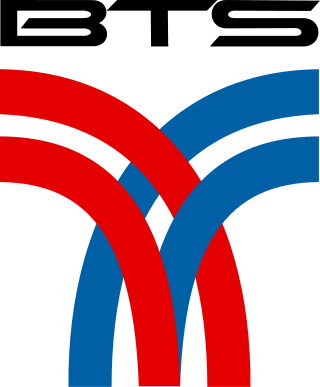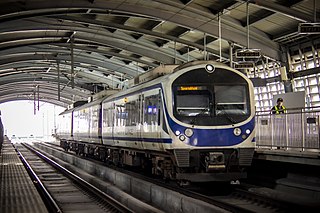
The Bangkok Mass Transit System, commonly known as the BTS Skytrain, is an elevated rapid transit system in Bangkok, Thailand. It is operated by Bangkok Mass Transit System PCL (BTSC), a subsidiary of BTS Group Holdings, under a concession granted by the Bangkok Metropolitan Administration (BMA) which owns the lines. The system consists of 62 stations along three lines with a combined route length of 70.05 kilometers (43.53 mi). The BTS Sukhumvit Line runs northwards and south-eastwards, terminating at Khu Khot and Kheha respectively. The BTS Silom Line which serves Silom and Sathon Roads, the central business district of Bangkok, terminates at National Stadium and Bang Wa. The Gold Line people mover runs from Krung Thon Buri to Klong San and serves Iconsiam. The lines interchange at Siam station and Krung Thon Buri. The system is formally known as "The Elevated Train in Commemoration of HM the King's 6th Cycle Birthday".

The Metropolitan Rapid Transit or MRT is a mass rapid transit system serving the Bangkok Metropolitan Region in Thailand. The MRT system comprises two fully operational rapid transit lines and one fully operational monorail line (Yellow). One monorail line (Pink) is in trial operation, with another rapid transit line (Orange) under construction. The MRT Blue Line, officially the Chaloem Ratchamongkhon Line, between Hua Lamphong and Bang Sue was the first to open in 2004 as Bangkok's second metro system. The MRT Blue line is officially known in Thai as rotfaifa mahanakhon (รถไฟฟ้ามหานคร) or "metropolitan electric train", but it is more commonly called rotfai taidin (รถไฟใต้ดิน), literally, "underground train" as it was distinguished from the BTS Skytrain by being completely underground when its first section between Hua Lamphong to Bang Sue opened.

The Airport Rail Link (ARL) is an express and commuter rail line in Bangkok, Thailand. The line provides an airport rail link from Suvarnabhumi Airport, via Makkasan station, to Phaya Thai station in central Bangkok. Most of the line is on a viaduct over the main eastern railway. It is owned by State Railway of Thailand (SRT) and, since 2021, operated by Asia Era One Company Limited. The 28.6-kilometer (17.8 mi)-long Airport Rail Link opened for service on 23 August 2010.

The Sukhumvit Line is an elevated metro rail line of the BTS Skytrain in Bangkok, Thailand. From the central Siam Station, where it connects with the Silom Line, the line runs both northwards along Phaya Thai and Phahon Yothin Roads to Khu Khot in Lam Luk Ka District in Pathum Thani, and eastwards along Rama I, Phloen Chit and Sukhumvit Roads, through Bang Na District to Kheha Station in Samut Prakan. BTS daily ridership (2019) is 740,000 passengers per day.

The BTS Silom Line is an elevated rapid transit line of the BTS Skytrain in Bangkok, Thailand. It is operated by Bangkok Mass Transit System PCL (BTSC), a subsidiary of BTS Group Holdings, under a concession granted by the Bangkok Metropolitan Administration (BMA). The line serves Silom and Sathon Roads, the central business district of Bangkok, terminates at National Stadium and Bang Wa. The line is 14 km in length and consists of 14 stations.

Rail transport plays a crucial role in connecting various regions of Thailand, transporting both goods and passengers through a range of transportation options that include inter-city and commuter rail, mass rapid transit, monorails, and airport rail links. The State Railway of Thailand (SRT) operates a network of intercity railways spanning 4,845.1 kilometers, covering 47 provinces across the country. SRT is committed to developing railway lands through its subsidiary, SRT Asset (SRTA), which focuses on transit-oriented development (TOD) initiatives. The Krung Thep Aphiwat Central Terminal in Bangkok serves as the primary transportation hub for rail transport in Thailand, connecting various types of rail transportation throughout the country. It covers an area of 274,192 square meters, making it the largest railway station in Southeast Asia, and is situated in a new central business district (CBD) that is currently being developed.

The MRT Purple line or MRT Chalong Ratchatham line is Bangkok's fifth rapid transit line, following the Sukhumvit Line, Silom Line, MRT Blue Line, and Airport Rail Link. The line is 23 km (14 mi) long, serving the north-western area of Bangkok running from Tao Poon to Klong Bang Phai in Nonthaburi Province.

The MRTYellow Line is an elevated monorail line in Bangkok and Samut Prakan Province, Thailand, part of the MRT rapid transit system. The 30.4 km (18.9 mi) line has 23 stations and cost 55 billion baht. The line was originally proposed in 2005 by the Office of Transport and Traffic Policy and Planning to be a heavy rail underground line along Lat Phrao road which was then elevated from Lam Sali Intersection to Samrong. However, it was decided in 2012 to build an elevated monorail line for the whole length in order to reduce construction costs.

The SRT Dark Red Line, is part of the SRT Red Line suburban railway system to serve the greater Bangkok Metropolitan Region running for 26 km (16 mi) between Krung Thep Aphiwat and Rangsit.

The SRT Light Red Line, or Nakhon Withi Line is a 15 km (9.3 mi) between Krung Thep Aphiwat Central Terminal and Taling Chan and is part of the SRT Red Lines suburban railway system serving the greater Bangkok Metropolitan Region.

Bangkok has 9.7 million automobiles and motorbikes, a number the government says is eight times more than can be properly accommodated on existing roads. And those numbers are increasing by 700 additional cars and 400 motorbikes every day. Charoen Krung Road, the first road to be built by Western techniques, was completed in 1864. Since then, the road network has expanded to accommodate the sprawling city's needs. Besides roads, Bangkok is served by several other transport systems. Bangkok's canals and ferries historically served as a major mode of transport, but they have long since been eclipsed by land traffic. A complex elevated expressway network and Tollway helps bring traffic into and out of the city centre, but Bangkok's rapid growth has put a large strain on infrastructure. By the late-1970s, Bangkok became known as "the city of traffic disaster". Although rail transport was introduced in 1893 and electric trams served the city from 1894 to 1968, it was only in 1999 that Bangkok's first rapid transit system began operation. Older public transport systems include an extensive bus network and boat services which still operate on the Chao Phraya and two canals. Taxis appear in the form of cars, motorcycles, and tuk-tuks.

The MRT Blue Line or MRT Chaloem Ratchamongkon Line is Bangkok's third rapid transit line, following the Sukhumvit line and Silom line of the BTS Skytrain. It is the first of the MRT system and is operated by Bangkok Expressway and Metro (BEM). The original 20 km (12.43 mi) MRT Blue Line from Hua Lamphong to Bang Sue opened on 3 July 2004. A 1.2 km (0.75 mi) extension to Tao Poon opened on 11 August 2017. The 15.9 km (9.88 mi) western extension to Lak Song opened for full service on 29 September 2019 and the 11 km (6.84 mi) extension from Tao Poon to Tha Phra to form the quasi loop, opened for full service on 30 March 2020.
The Light Blue Line is a planned monorail line to be built in Bangkok, Thailand. Its path runs along a north–south axis. This line would link the Din Daeng housing community areas, Bangkok City Hall 2, Makkasan Station, and the business area along Sathon Road.

The Mass Rapid Transit Master Plan in Bangkok Metropolitan Region, or M-Map, is the latest version in a series of Thai government plans for the development of an urban rail transit network serving the Greater Bangkok area. It was drafted under the care of the Office of Transport and Traffic Policy and Planning (OTP) of the Ministry of Transport.

Greater Bangkok commuter rail is a commuter rail system in Bangkok Metropolitan Region, Phra Nakhon Si Ayutthaya Province, Saraburi Province, Lopburi Province, Suphan Buri Province, Ratchaburi Province, Chacheongsao Province, Nakhon Nayok Province, Prachinburi Province, and Samut Songkhram Province. It runs from and to the outskirts of the city during the rush hour, and the passenger number is high. It is operated by State Railway of Thailand (SRT) that also operates inter-city rail. Commuter rail services always have number 3xx. Most of the system are double track.

Krung Thep Aphiwat Central Terminal, also known by its former name Bang Sue Grand Station, is the central passenger terminal in Bangkok and the current railway hub of Thailand. It replaced the existing Hua Lamphong railway station as the city's central railway station, with long-distance rail services operating from here from 19 January 2023. The station was opened on 2 August 2021 as part of the operation of the SRT Red Lines, and from May 2021 to September 2022 served as a COVID-19 vaccination center. It is linked to the Bang Sue MRT station via an underground walkway.
The BMA Bang Na–Suvarnabhumi line is a proposed light rail line in Bangkok that would run from Bang Na junction to Suvarnabhumi Airport. The line was first proposed in 1994, but it was not included in the 2005 OTP Mass Rapid Transit Master Plan. Initially, it was planned for the line to potentially be a BTS Sukhumvit Line branch line with turnouts constructed near Bang Na junction. In December 2015, the BMA said it would advance construction and would propose it to cabinet in the near future. In April 2016, deputy governor Amorn Kitchawengkul said the project would take 3–6 years and cost THB 20 billion.

The Gold Line is an automated people mover line, part of Bangkok's rapid transit system. The line is 1.8 km (1.1 mi) long, consisting of 3 stations, and was opened by Thai Prime Minister Prayut Chan-o-cha on 16 December 2020. It primarily serves as a feeder line between the BTS Silom line and Iconsiam shopping center. The line will be extended 1 km (0.62 mi) along Somdet Chao Phraya road to connect with the future MRT Purple Line southern extension. When completed, it will connect Krung Thon Buri BTS station with Prajadhipok Road in Thon Buri District for a total distance of 2.68 km (1.67 mi).

Kheha is a BTS Skytrain station, on the Sukhumvit Line in Samut Prakan, Thailand.




































